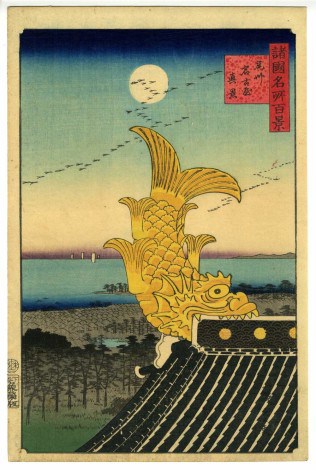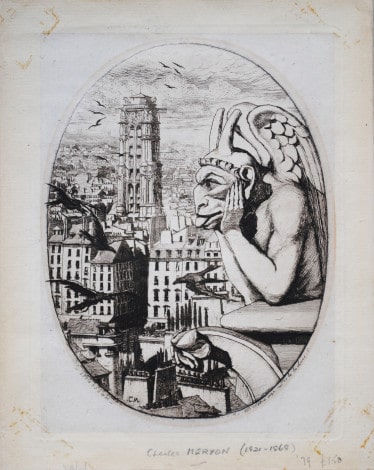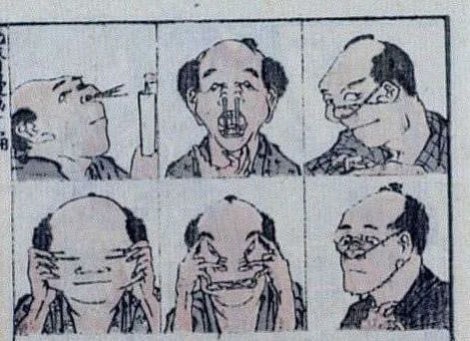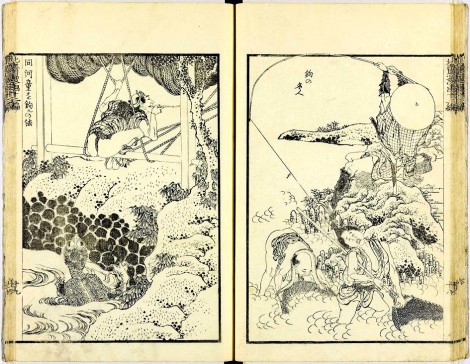Hokusai and Riviere: Thirty-six Views Compared and the Hokusai Manga
If the hugely popular Kuniyoshi Utagawa exhibition recently held at the Hiroshima Prefectural Art Museum whet your appetite for ukiyo-e woodblock prints (or if you missed it) you can now get another dose of the art form in neighboring Kure.
The Hokusai and Rivière exhibition currently showing at the Kure Municipal Museum of Art is another excellent show and in some ways is more accessible for the non-reader of Japanese than the Kuniyoshi show.
The main theme of the exhibition is Hokusai’s 36 Views of Mt Fuji series of prints and the 36 Views of the Eiffel Tower series of lithographs by Henri Rivière inspired by them. As well as the 46 prints in the Mt Fuji series (which was expanded as it proved so popular) and Rivière’s lithographs on display, there are also several rooms devoted to Hokusai “manga”.
The manga are collections of “whimsical” and sometimes quite random drawings which depict everything from everyday life, nature, architecture and machinery as well as images of legendary beats and historical figures. The first of these collections, published in 1814, was the bestselling book in Japanese history up to that time and 14 more volumes followed over the next 64 years. The manga are indeed whimsical and the exhibition begins with Hokusai’s studies of “portly people”. It then moves on to “thin people”, before continuing on to a huge range of topics from people making funny faces, the depictions of ordinary townsfolk going about their daily business for which Hokusai became well known, animals, birds, bugs and flora to guns, architecture and machinery – all in incredible detail. Other themes covered include famous places, legendary and historical figures and some goulish sketches for good measure.
Those who like to take riverside strolls might like to take a close look at the How to catch a kappa.
The manga sketches are not labelled in English, but many of the titles do have hiragana written above the Japanese kanji characters. There are also some original wood blocks on display which give you an idea of just how much skill is required to produce these images.
All 46 prints in the 36 Views of Mt Fuji series are labelled in English as well as Japanese, and starts with the hugely famous Great Wave off Kanagawa. Those new to the world of ukiyo-e may like to watch the DVD on loop at the top of the stairs on the second floor before heading into the Views of Mt Fuji room. It gives a good idea of the painstaking process of creation these prints.
The third part of the exhibition is Henri Riviere’s series of lithographs 36 Views of The Eiffel Tower, published in 1902, during the European Japonisme movement and directly inspired by Hokusai’s Mt Fuji series. The prints are lovely and several are displayed alongside an example of ukiyo-e thought to have referenced or influenced it.
Riviere’s De Notre Dame depicts one of Notre Dame’s gargoyles,

Inspired by the depiction of one of Nagoya Castle’s famous golden carp from Utagawa Hiroshge II’s One Hundred Famous Views in the Various Provinces ukito-e series?

This etching by Charles Meryon from 1854 also gets a mention.

The recent Kuniyoshi exhibit in Hiroshima city was remarkable for the both the artwork on display and the crowds that went to see it. Hokusai will be the subject of a large exhibition at the Hiroshima Prefectural Art Museum at the beginning of next year, but if you want to enjoy the luxury of viewing some of his best work relaxed and unhurried, I highly recommend a trip out to Kure.
Hokusai’s 36 Views of Mt Fuji can be viewed on Wikipedia here.
continues at Kure Municipal Museum of Art until November 23, 2015. Click here for more details.
Links




